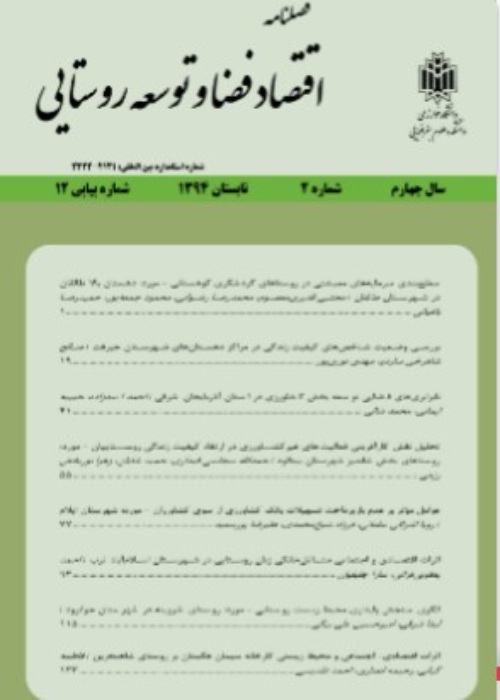Spatial Analysis of Development of Boarder Regions in East Iran Case Study: Border villages in South Khorasan Province
Author(s):
Abstract:
Introduction When unbalanced spatial dispersion of developmental indicators increase, unbalanced distribution of facilities and population will dramatically increase too and meanwhile the increase of centralization of indicators in regions that suffer from centralization of facilities and population will lead to population and facilities movement from deprived regions and this will increase unbalanced spatial-geographical dispersion. So, achieving sustainable development of human force is impossible. For achieving sustainable development as the ultimate goal of planning, the first step is studying and recognizing the current situation and the level of distribution of facilities in regions as a starting point for achieving development. Planning which its goal is sustainable development in settlements especially in border regions, needs spatial organization in rural regions to organize macro and national issues including national security issues more precisely and more efficiently. Therefore, in this study compatibility or incompatibility in spatial dispersion of development pattern in South Khorasan villages are evaluated and classified regarding some indicators such as infrastructure, social-economic, education and culture, and health. According to the results of this study, it seems that spatial organization in border counties and villages located in South Khorasan is extremely unbalanced and incompatible.
Methodology Regarding its methodology, this study is a cause and effect-comparative one and regarding its nature it is a practical study. 23 indicators have been chosen out of developmental indicators which include socioeconomic, educational-cultural, health and infrastructural ones. Data were collected through documentary research using documents of government offices in 1392, in four cities which are located in South Khorasan border (Nehbandadn, Darmiyan, Zirkuh and Sarbisheh). Statistical population includes villages located in border counties in South Khorasan province and the study samples regarding statistical population have been determined 11 villages according to the separation of political boundaries in villages. To classify border villages of this province according to the level of getting facilities according to the studied indicators, TOPSIS approach and Shannon Entropy Coefficient have been used to determine the weight coefficient of each of the indicators.
Discussion and Conclusion In recent years, planners and politicians are interested in studying the unbalanced spatial dispersion in different geographical areas and the existence of unbalanced conditions in different dimensions is an important sign of undeveloped regions. This study tries to reveal the importance of getting more of economic indicators through a critical realism point of view by answering to this question that "how border rural districts of South Khorasan province are related to their socioeconomic context as an organization? It seems that by evaluating spatial condition, it is possible to achieve to a total indicator of security status; therefore it is expected that security status will not be in a good condition when a region gets less of economic indicators. The study result showed that Mood rural district have the best condition in evaluating socioeconomic, educational-cultural, health and infrastructural indicators and as a result in final classification this rural district is the only district among border rural districts in South Khorsan province which gets the most facilities. Studies show that rural districts, Mood, Doroh, MomenAbad, Mighan and Shusf are respectively in the first to fifth grade, regarding balanced spatial development pattern. In this classification, four rural districts, Ghohestan, Miyandasht, Naharenjan, Arabkhane are deprived rural districts respectively. On the whole, in South Khorasan province among 11 rural districts as study samples, regarding socialeconomic, educational-cultural, health and infrastructural indicators, 6 rural districts including Doroh, MomenAbad, Mighan, Bandan, Shusf ans Gezik are recognized as rural districts that get less facilities and four of them including Ghohestan, Miyandashtn Naharenjan and Arabkhane are recognized as deprived rural districts respectively. Mood rural district is the only case that encompasses all of this study indicators, however this region is not in a desirable situation and its numerical distance from developmental indicators is almost a lot. Such pattern shows the incompatible and unbalanced characteristic of spatial construction in border counties of South Khorasan province.
Methodology Regarding its methodology, this study is a cause and effect-comparative one and regarding its nature it is a practical study. 23 indicators have been chosen out of developmental indicators which include socioeconomic, educational-cultural, health and infrastructural ones. Data were collected through documentary research using documents of government offices in 1392, in four cities which are located in South Khorasan border (Nehbandadn, Darmiyan, Zirkuh and Sarbisheh). Statistical population includes villages located in border counties in South Khorasan province and the study samples regarding statistical population have been determined 11 villages according to the separation of political boundaries in villages. To classify border villages of this province according to the level of getting facilities according to the studied indicators, TOPSIS approach and Shannon Entropy Coefficient have been used to determine the weight coefficient of each of the indicators.
Discussion and Conclusion In recent years, planners and politicians are interested in studying the unbalanced spatial dispersion in different geographical areas and the existence of unbalanced conditions in different dimensions is an important sign of undeveloped regions. This study tries to reveal the importance of getting more of economic indicators through a critical realism point of view by answering to this question that "how border rural districts of South Khorasan province are related to their socioeconomic context as an organization? It seems that by evaluating spatial condition, it is possible to achieve to a total indicator of security status; therefore it is expected that security status will not be in a good condition when a region gets less of economic indicators. The study result showed that Mood rural district have the best condition in evaluating socioeconomic, educational-cultural, health and infrastructural indicators and as a result in final classification this rural district is the only district among border rural districts in South Khorsan province which gets the most facilities. Studies show that rural districts, Mood, Doroh, MomenAbad, Mighan and Shusf are respectively in the first to fifth grade, regarding balanced spatial development pattern. In this classification, four rural districts, Ghohestan, Miyandasht, Naharenjan, Arabkhane are deprived rural districts respectively. On the whole, in South Khorasan province among 11 rural districts as study samples, regarding socialeconomic, educational-cultural, health and infrastructural indicators, 6 rural districts including Doroh, MomenAbad, Mighan, Bandan, Shusf ans Gezik are recognized as rural districts that get less facilities and four of them including Ghohestan, Miyandashtn Naharenjan and Arabkhane are recognized as deprived rural districts respectively. Mood rural district is the only case that encompasses all of this study indicators, however this region is not in a desirable situation and its numerical distance from developmental indicators is almost a lot. Such pattern shows the incompatible and unbalanced characteristic of spatial construction in border counties of South Khorasan province.
Keywords:
Language:
Persian
Published:
Quarterly Journal of Space Economy & Rural Development, Volume:4 Issue: 4, 2016
Pages:
147 to 167
magiran.com/p1624236
دانلود و مطالعه متن این مقاله با یکی از روشهای زیر امکان پذیر است:
اشتراک شخصی
با عضویت و پرداخت آنلاین حق اشتراک یکساله به مبلغ 1,390,000ريال میتوانید 70 عنوان مطلب دانلود کنید!
اشتراک سازمانی
به کتابخانه دانشگاه یا محل کار خود پیشنهاد کنید تا اشتراک سازمانی این پایگاه را برای دسترسی نامحدود همه کاربران به متن مطالب تهیه نمایند!
توجه!
- حق عضویت دریافتی صرف حمایت از نشریات عضو و نگهداری، تکمیل و توسعه مگیران میشود.
- پرداخت حق اشتراک و دانلود مقالات اجازه بازنشر آن در سایر رسانههای چاپی و دیجیتال را به کاربر نمیدهد.
In order to view content subscription is required
Personal subscription
Subscribe magiran.com for 70 € euros via PayPal and download 70 articles during a year.
Organization subscription
Please contact us to subscribe your university or library for unlimited access!



